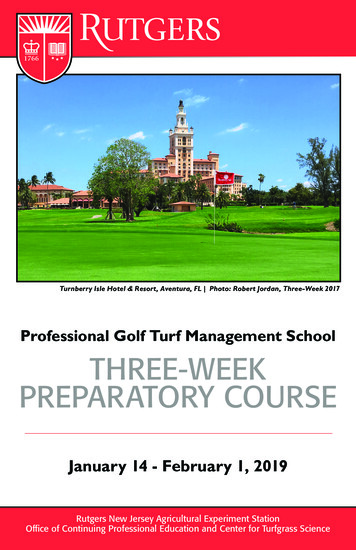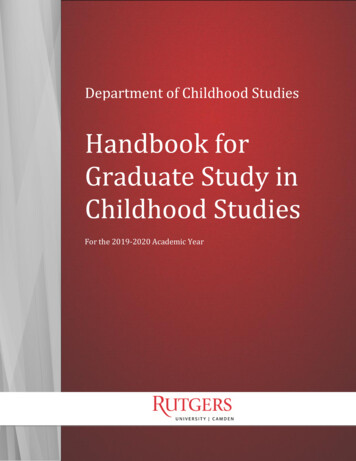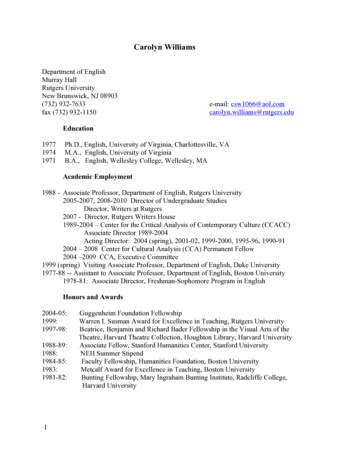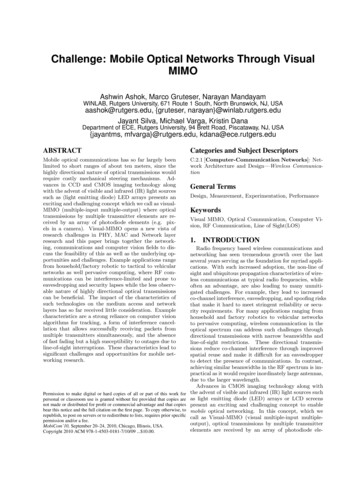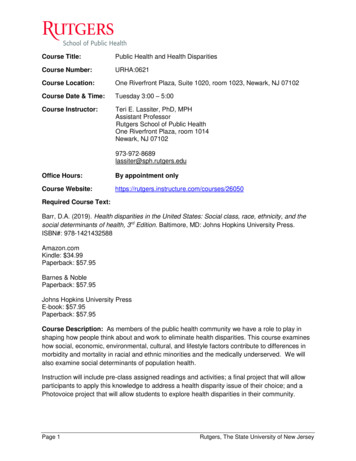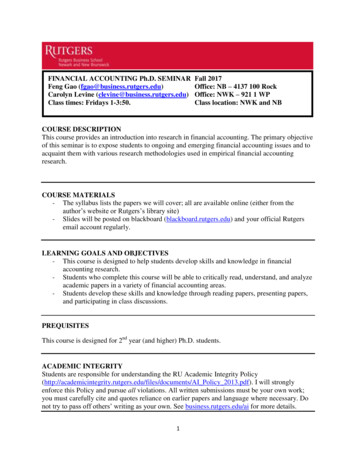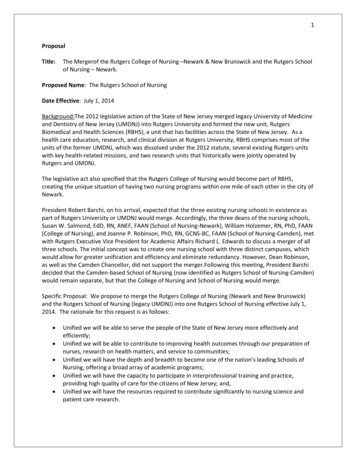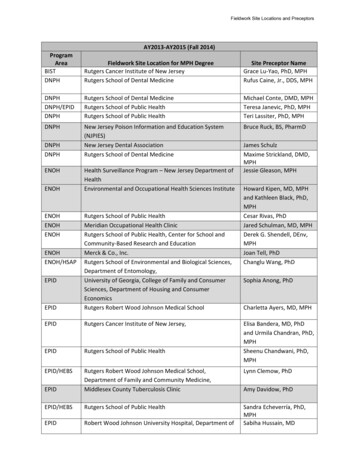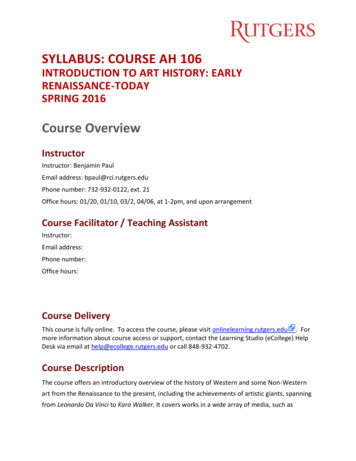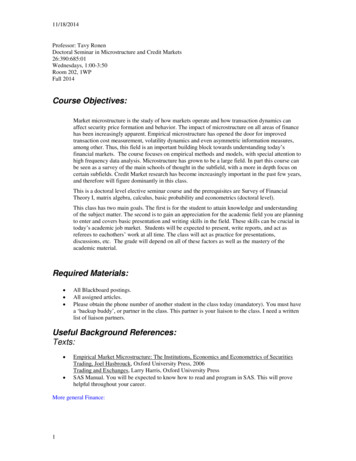
Transcription
11/18/2014Professor: Tavy RonenDoctoral Seminar in Microstructure and Credit Markets26:390:685:01Wednesdays, 1:00-3:50Room 202, 1WPFall 2014Course Objectives:Market microstructure is the study of how markets operate and how transaction dynamics canaffect security price formation and behavior. The impact of microstructure on all areas of financehas been increasingly apparent. Empirical microstructure has opened the door for improvedtransaction cost measurement, volatility dynamics and even asymmetric information measures,among other. Thus, this field is an important building block towards understanding today’sfinancial markets. The course focuses on empirical methods and models, with special attention tohigh frequency data analysis. Microstructure has grown to be a large field. In part this course canbe seen as a survey of the main schools of thought in the subfield, with a more in depth focus oncertain subfields. Credit Market research has become increasingly important in the past few years,and therefore will figure dominantly in this class.This is a doctoral level elective seminar course and the prerequisites are Survey of FinancialTheory I, matrix algebra, calculus, basic probability and econometrics (doctoral level).This class has two main goals. The first is for the student to attain knowledge and understandingof the subject matter. The second is to gain an appreciation for the academic field you are planningto enter and covers basic presentation and writing skills in the field. These skills can be crucial intoday’s academic job market. Students will be expected to present, write reports, and act asreferees to eachothers’ work at all time. The class will act as practice for presentations,discussions, etc. The grade will depend on all of these factors as well as the mastery of theacademic material.Required Materials: All Blackboard postings.All assigned articles.Please obtain the phone number of another student in the class today (mandatory). You must havea ‘backup buddy’, or partner in the class. This partner is your liaison to the class. I need a writtenlist of liaison partners.Useful Background References:Texts: Empirical Market Microstructure: The Institutions, Economics and Econometrics of SecuritiesTrading, Joel Hasbrouck, Oxford University Press, 2006Trading and Exchanges, Larry Harris, Oxford University PressSAS Manual. You will be expected to know how to read and program in SAS. This will provehelpful throughout your career.More general Finance:1
11/18/2014These are only suggested reference as background if you encounter something you feel shaky on. By nomeans do I suggest you go out and buy all of these now! This list is simply here to make life a bit easier foryou.Campbell, Lo and MacKinley, 1997, The Econometrics of Financial Markets, Princeton University Press.Copeland, Thomas E. and J. Weston, 1992, Financial Theory and Corporate Policy, 3 rd Edition, AddisonWesley Publishing Company.Huang, Chi-fu and Robert Litzenberger, 1988, Foundations or Financial Economics, Prentice Hall ISBN 013-500653-8Ingersoll, Jonathan, 1987, Theory of Financial Decision Making, Rowman and Littlefield.Excellent website for doctoral students:http://www-2.iies.su.se/ masa/tips4economists.htmlI looked for something that can help guide you in writing the mock referee report and found this excellentsite with many helpful links.Microstructure:The theory and practice of microstructure also relies on institutional structure. While I mightprovide some coverage, since the institutions change so fast that (a) trading practices are not welldocumented, and (b) knowledge of institutional detail has a rapid decay rate, I will expect you tokeep up on this end yourselves as much as possible. The web is an excellent source, as well assome texts that are not necessarily up to date, but are a good start:O'Hara, Maureen, 1995, Market Microstructure Theory (Blackwell Publishers, Cambridge, MA) –doctorallevel, but really theory oriented, not our main focus.Trading and Exchanges, Harris, Lawrence E., 2003, Oxford university Press, New York.Equity Markets in Action, The Fundamentals of Liquidity, Market Structure & Trading, Schwartz andFrancioni, Wiley, 2004, ISBN: 0-471-46922-XResources:The Wharton Research Data Services (WRDS) is your source for the TAQ trade and quote datafor US equities, for TRACE bond data, and most other databases you will access. Make sure you arefamiliar with it.The web site for Joel Hasbrouck’s book (Empirical Market Microstructure) has links to SAS programs anddata (which illustrate some of the techniques in the book). Also, you will find Joel’s Mathematica programsused to develop many of the results in the book. (Mathematica is a symbolic math manipulation program).For the sections of the course that cover Joel Hasbrouck’s book, we will be following his class notes andlectures, which are in the public domain and are designed to facilitate the reading of the book. They are alsomuch more updated than the textbook in terms of more recent events and changes in the trading world.Class Organization/Weekly Assignments:2
11/18/2014This is a seminar course. Each week we will cover several papers within one subtopic.There will be one midterm exam. One of your presentations will be submitted as a full-fledged paper at theend of term, and will be empirical, using at least one of TRACE or TAQ data, on the intradaily level. Youwill have assignments weekly.Grades:Class Participation/Preparation/Synopses/Written weekly work: 35 percentPresentation/Discussion/Oral Skills: 25 percentMidterm: 20 percentProject: 20 percentThe exam and presentation dates will be announced soon. These dates cannot be changed. Onceannounced, firm. Please make arrangements to adhere to them.Office hours:Mondays, 11:00-11:30 am; My office is 1128. Tel: 1-973-353-5272. I don’t really get my messages so it isbetter to email me, leave me your phone numbers, and I will call you back.E--mail policy: (tronen@andromeda.rutgers.edu)You may prefer to ask me questions by e--mail. Your message MUST include a subject and your name,clearly identifying yourself as my student. Please make sure your Email queries are self contained, and canbe answered in a reasonably short way.3
11/18/2014Tentative Schedule: subject to change!Dates: September 3Meeting 1Topic 1: Introduction to course: Course objectives, requirements, general overview, What isMicrostructure?Dates: September 10Meeting 2Topic: Introduction to MicrostructureBefore arriving:Survey/Institutional Articles/Data1. Madhavan (2000), Market Microstructure: A survey, Journal of Financial Markets 3, 205-2582. Biais, Glosten and Spatt (2002), The Microstructure of Stock Markets, Universite de Toulouse.3. Comerton-Forde and Rydge (2004), A Review of Stock Market Microstructure (SecuritiesIndustry Research Centre of Asia-Pacific, Sydney).Basic Models:4. Roll, Richard, 1984: A simple implicit measure of the effective bid ask spread in an efficientmarket, Journal of Finance 39, 1127-1139.*Assignment: Prepare a 10 minute presentation on ‘What is Microstructure’. Your assignment is toteach MBA students the day 1 outline on what this field is. My expectation is that you will havestarted with this but downloaded all cited articles that are mentioned here that YOU think areimportant, and that you have done a supplementary literature search on refereed articles. Do notsearch for similar courses and simply rewrite.You will be tested on your presentation skill, the content, how effective you area at teaching,timing yourself, how you answer questions, etc.Lectures will be on architecture of markets.Dates: September 17Meeting 3Topic: Introduction to Microstructure Sequential Trade models of Asymmetric Information, andContinuous Auction Models (Strategic Trade)1. Glosten, Lawrence R. and Paul R. Milgrom, 1985, Bid, ask, and transaction prices in aspecialist market with heterogeneously informed traders. Journal of Financial Economics 14, 71100;*2. Kyle, Albert S., 1985, Continuous auctions and insider trading. Econometrica 53, 1315-1336;*3. Anat R. Admati and Paul Pfleiderer, 1988, A Theory of Intraday Patterns: Volume and PriceVariability , The Review of Financial Studies, Vol. 1, No. pp. 3-40 *4
11/18/2014More seminal articles:4. Glosten, Lawrence R., 1989, Insider trading, liquidity, and the role of the monopolistspecialist. Journal of Business 62, 211-35;5. Foster, D., and S. Viswanathan, 1990, A Theory of the Intraday Variations in Volume, variance,and Trading Costs in Securities Markets, Review of Financial Studies 3, 593-624.Assignment: This week, each of you will be preparing a 10 minute presentation on one of thesearticles, which I will assign to you one week in advance. Your assignment is to teach your fellowdoctoral student classmates the paper (not me). My expectation is that you will have started withthis but downloaded all cited articles that are mentioned here that YOU think are important, andthat you have done a supplementary literature search on refereed articles. Do not search for similarcourses and simply rewrite.You will be tested on your presentation skill, the content, how effective you are at explainingdifficult concepts, interest level, timing yourself, how you answer questions, etc.Lectures will be on architecture of markets.Dates: September 24:Meeting 4I will be unable to come to class because of the Jewish Holiday. However, I would like you to meet in theclassroom for a minimum of 1.5 hours to learn the data sets together (I prefer 3 hours). You need to figureout how to go onto TAQ, and TRACE. Review each of these data sets and the documentation togethercarefully. Some of you are familiar with some of these data sets but not others. I expect the more seasonedstudents to help the others. I expect a report at the end of this session from each person: In-classassignment: Together, each of you will download 5 firms’ data for one day, both stock and bond, You willalso get all the Bond data. Then, together you will figure out for the stock: how match all the quotes withthe transactions for the stock. Make sure you are all good with SAS. Then, in SAS, compute the basicstatistics that you think are interesting on these data. I will say no more. Each of you must submit a reporton what happened in class, who helped you the most, or who you helped, what you learned, what the issuesthat had you stuck are, where you think you want to improve in your knowledge of these issues. What theproblem areas were, and of course, your results.Dates: October 1:Meeting 6Topic: MechanismsAssignment: Prepare a 20 minute class on ‘How this exchange operates today’. Your assignmentis to teach UNDERGRAD students the current day market architecture for your assigned market.Submit to me serious list of references you used to put together your lecture. Do not search forsimilar courses and simply rewrite.You will be tested on your presentation skill, the content, how effective you are at teaching, timingyourself, how you answer questions, etc. You must assign ‘reading’ to the students as well ashomework. The assigned reading and the biblio materials must be submitted to me at least 24hours in advance.NYSEOTC STOCKS- FINRATHE EVOLUTION OF ECNS TO PRESENT DAYCORPORATE BOND MARKETTREASURY MARKETLectures will be on architecture of markets.A,B,C,D,E letters will be assigned5
11/18/2014SECTION 2:Each week (unless otherwise specified):For the second portion of the course, we will have a simple rotation: Each week you will be assigned yourrotated weekly role (A,B,C,D or E). If you are ‘A’ one week ‘I’, you will be ‘B’ on week ‘i 1’.Each student will have the following task, as per their letter role for the week.BEFORE THE WEEK BEGINS:PERSON A writes a literature review that they feel is pertinent for the class to be able to understand Article0. This must be emailed to me by Friday 9PM (preceding the Wednesday class). It must also be put onblackboard and all pertinent articles must be downloaded and attached. This literature review ‘places’ thearticle.Students B and C and D must submit ‘referee reports’ to me by email by Monday (preceding theWednesday lecture)During the lecture:Person B DISCUSSES the assigned paper during the Wednesday lecture as though they are a discussant ata conference. (hand in before class to me).PERSON E presents their research idea based on the paper from the PRECEDING week. The writtenportion must be submitted to me AND to person D by Monday preceding the lecture.PERSON C discusses E’s research proposal during the lecture as though they are a discussant at aconference. (please hand written discussion in before class to me).Group discussion and questions on C’s presentation and topic.A, B, D write comments on the research paper and the presentation to TR only. Due Friday 9PM after thepresentation.The following week, person E (who will by then become ‘A’) presents their revised work.Note: it is your responsibility at all times to identify relevant references and scan and upload all relevantpapers.Dates: October 8:Meeting 7Topic: Empirically Speaking .Empirical Evidence on Intraday Patterns:SEE THE DEADLINES THAT COME BEFORE THIS DATE!!!!0. What’s Not There: The Odd- Lot Bias in Taq Data, Working paper, O’ Hara Yao YeRequired reading:6
11/18/20141. Wood, R., McInish T., Ord, K., 1985. An Investigation of Transactions data for NYSE stocks,Journal of Finance 40, 723-7392. Jain, P. and G. Joh, 1988, The Dependence Between Hourly Prices and TradingVolume, Journal of Financial and Quantitative Analysis 23, 269-284.3. McInish, T., and R. Wood, 1992, An Analysis of Intraday Patterns in Bid/Ask Spreads forNYSE Stocks, Journal of Finance 47, 753-764.4. Chan, KC, W. Christie, and P. Schultz, 1995, Market Structure and the Intraday Patterns of BidAsk Spreads for Nasdaq Securities, Journal of Business 68, 35-60.5. Lee, C., and M. Ready, 1991, Inferring Trade Direction from Intraday Data, Journal of Finance,46, 733-746.Dates: October 15:Meeting 8Empirical Work on decomposing the spread , on orders and prices0.Price Constraints, Speed Competition, and Liquidity, Yao YeRequired reading:1. Stoll, H., 1989, Inferring the Components of the Bid-Ask Spread: Theory and EmpiricalTests, Journal of Finance 44, 115-134.2. Hasbrouck, Joel, 1993, Assessing the quality of a security market: A new approach totransaction-cost measurement. Review of Financial Studies 6, 191-212*3. Madhavan, A., Richardson, M., and M. Roomans, 1997, Why Do Security Prices Change? ATransaction-Level Analysis of NYSE Stocks, Review of Financial Studies 6, 345-374.4. GeorgeT., and Hwang, C., 1995. Transitory Price Changes and Price Limit Rules: Evidencefrom the Tokyo Stock Exchange. Journal of Financial and Quantitative Analysis 30, 313-327.5. Biais, B, Hillion, P., and C., Spatt, 1995, An Empirical Analysis of the Limit Order Book andthe Order Flow in the Paris Bourse, Journal of Finance 50, 1655-1689.Dates: October 22:Meeting 9Topics: Corporate Bonds, TraceTHIS WEEK JUST READ THE PAPERS, ALL OF THEM. AAssignment: Know this body of literature extremely well. Write a literature review. Submit to mea two page literature review. Pretend it is part of the introduction of a paper you are writing, orpart of the ‘literature review’ of a paper you are writing. You will be graded not only on thecontent and organization and understanding but on your writing skill. Your literature reviews willbe graded comparatively.7
11/18/20141. Kwan, Simon H., 1996, Firm-specific information and the correlation betweenindividual stocks and bonds, Journal of Financial Economics 40, 63-80.2. Hong, Gwangheon., and Arthur D. Warga, 2000, An empirical study of bond markettransactions, Financial Analysts Journal 56, 32-46.3. Alexander, Gordon J., Edwards, Amy K., and Michael G. Ferri, 2000, Thedeterminants of trading volume of high-yield corporate bonds, Journal of FinancialMarkets 3, 177-204.4. Schultz, Paul H., 2001, Corporate bond trading costs and practices: a peek behind thecurtain, Journal of Finance 56, 677-698.5. Hotchkiss, Edith S., and Tavy Ronen, 2002, The informational efficiency of thecorporate bond market: an intraday analysis, Review of Financial Studies 15, 1325-1354.6. Spatt, Chester S., 2004, Frictions in the bond market, Keynote address at the secondMTS conference on financial markets: The organization and performance of fixedincome markets, Vienna, December 16, 2004.7. Biais, Bruno., and Richard Green, 2007, The microstructure of the bond market in the20th Century, IDEI Working Paper, n. 482.8. Biais, B. and F. Declerk, 2007, Liquidity, Competition and Price Discovery in theEuropean Corporate Bond Market, working paper, Toulouse School of Economics9. Goldstein, Michael A., and Edith S. Hotchkiss, 2007, Dealer behavior and the tradingof newly issued corporate bonds, Working paper, Boston College.10. Bao, Jack, Pan, Jun, and Jiang Wang, 2008, Liquidity of corporate bonds, WorkingPaper, MIT.11. Saunders, Anthony., Srinivasan, Anand., and Ingo Walter, 2002, Price formation inthe OTC corporate bond markets: a field study of the inter-dealer market, Journal ofEconomics and Business 54, 95-113.12. Downing, Christopher., Underwood, Shane, and Yuhang Xing, 2008. The relativeinformational efficiency of stocks and bonds: an intraday analysis, Journal of Financialand Quantitative Analysis, Forthcoming.13. Ronen, Tavy and Xing Zhou, 2009, Where Did All the Information Go? Trade in theCorporate Bond Market , Working Paper, Rutgers University.14. Mahanti, Sriketan, Nashikkar, Amrut, Subrahmanyam, Marti G., Chacko, George,Gaurav Mallik, 2008, Latent liquidity: A new measure of liquidity, with an application tocorporate bonds, Journal of Financial Economics88(2), 272-298.15. Jankowitsch, Rainer, Nashikkar, Amrut, and Marti G. Subrahmanyam, 2008, Pricedispersion in OTC markets: A new measure of liquidity, Working Paper, New YorkUniversity.8
11/18/2014Dates: October 29 Meeting 10 MIDTERM EXAM9
The Wharton Research Data Services (WRDS) is your source for the TAQ trade and quote data . For the sections of the course that cover Joel Hasbrouck's book, we will be following his class notes and . how match all the quotes with the transactions for the stock. Make sure you are all good with SAS. Then, in SAS, compute the basic .
